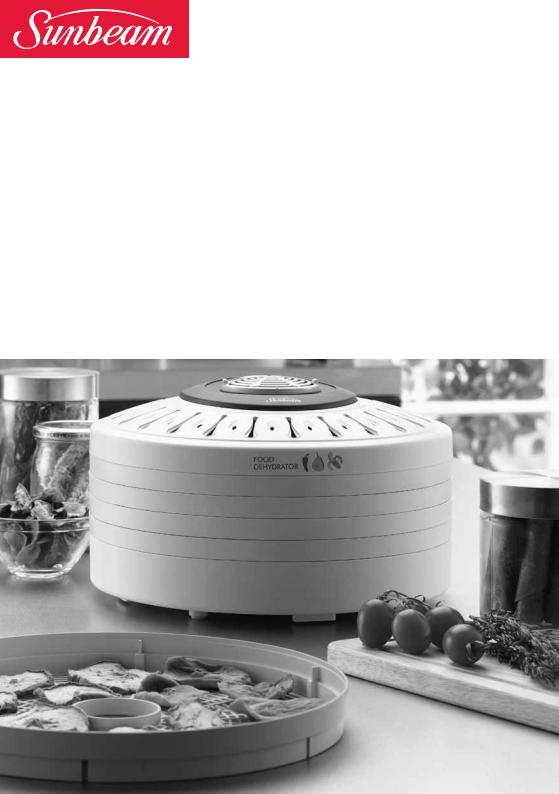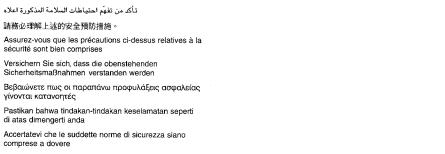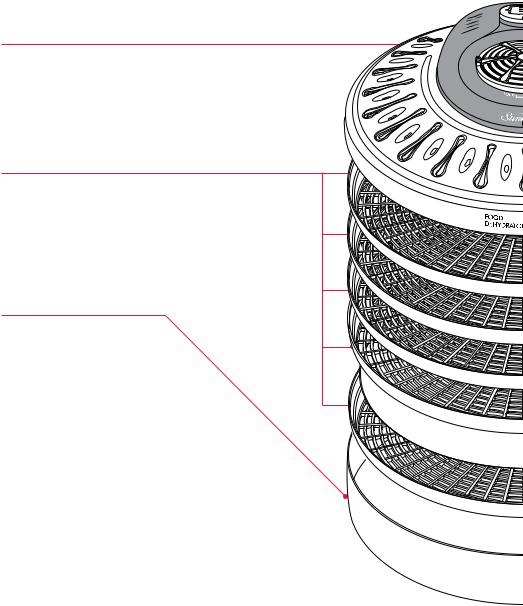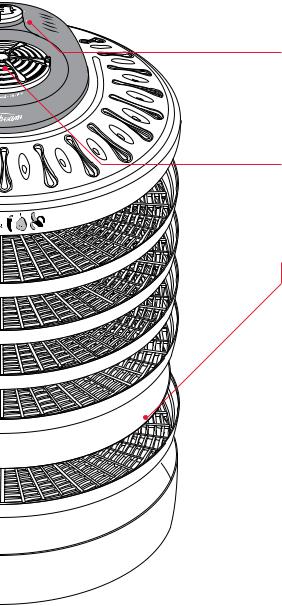Sunbeam DT5600 User Manual

Food Dehydrator
Healthy food dryer with 5 drying racks
Instruction/Recipe Booklet
DT5600
Please read these instructions carefully and retain for future reference.

Contents
Sunbeam’s Safety Precautions |
1 |
Features of your Food Dehydrator |
2 |
Using your Food Dehydrator |
4 |
Care and Cleaning |
6 |
Important Guidelines and Hints |
7 |
Storage of Dried Foods |
8 |
Rehydrating Dried Foods |
8 |
Use of Dried Food |
9 |
Drying Fruits |
9 |
Drying Chart for Fruit |
10 |
Drying Vegetables |
12 |
Fruit Rolls |
14 |
Drying Herbs and Spices |
15 |
Drying Chart for Herbs and Spices |
16 |
Drying Meat |
17 |
Drying Flowers |
18 |
Recipes |
19 |
Drying Record Chart |
29 |
Important instructions – retain for future use.

Sunbeam’s Safety Precautions
SAFETY PRECAUTIONS FOR YOUR SUNBEAM DEHYDRATOR.
•Ensure your dehydrator is used at least 50cm (half a metre) away from a gas flame or electric element.
•Do not operate the dehydrator on an inclined surface.
•Do not move or cover the dehydrator while in operation.
•Do not immerse the top of the dehydrator in water or any other liquid.
•Use your dehydrator well away from walls, curtains and cupboards that may be affected by steam.
•Do not use your dehydrator in confined spaces.
Sunbeam is very safety conscious when
designing and manufacturing consumer products, but it is essential that the product user also exercise care when using an electrical appliance. Listed below are precautions which are essential for the safe use of an electrical appliance:
•Read carefully and save all the instructions provided with an appliance.
•Always turn the power off at the power outlet before you insert or remove a plug. Remove by grasping the plug - do not pull on the cord.
•Turn the power off and remove the plug when the appliance is not in use and before cleaning.
•Do not use your appliance with an extension cord unless this cord has been checked and tested by a qualified technician or service person.
•Always use your appliance from a power outlet of the voltage (A.C. only) marked on the appliance.
•This appliance is not intended for use by persons (including children) with reduced physical, sensory or mental capabilities, or lack of experience and knowledge, unless they have been given supervision or instruction concerning use of the appliance by a person responsible for their safety.
•Children should be supervised to ensure that they do not play with the appliance.
•The temperature of accessible surfaces may be high when the appliance is operating.
•Never leave an appliance unattended while in use.
•Do not use an appliance for any purpose other than its intended use.
•Do not place an appliance on or near a hot gas flame, electric element or on a heated oven.
•Do not place on top of any other appliance.
•Do not let the power cord of an appliance hang over the edge of a table or bench top or touch any hot surface.
•Do not operate any electrical appliance with a damaged cord or after the appliance has been damaged in any manner. If damage is suspected, return the appliance to the nearest Sunbeam Appointed Service Centre for examination, repair or adjustment.
•For additional protection, Sunbeam recommend the use of a residual current device (RCD) with a
tripping current not exceeding 30mA in the electrical circuit supplying power to your appliances.
•Do not immerse the appliance in water or any other liquid unless recommended.
•Appliances are not intended to be operated by means of an external timer or separate remote control system.
•This appliance is intended to be used in household and similar applications such as: staff kitchen areas in shops, offices and other working environments; farm houses; by clients in hotels, motels and other residential type environments; bed and breakfast type environments.
If you have any concerns regarding the performance and use of your appliance, |
|
please visit www.sunbeam.com.au or contact the Sunbeam Consumer Service Line. |
|
Ensure the above safety precautions are understood. |
1 |

Features of your Food Dehydrator
Lid with drying motor
Acts as a lid for the Food Dehydrator and contains the motor and power switch. Air vents on the lid allow air to be circulated.
5 large drying racks
Holds the food in place for easy drying. Your unit includes 5 drying racks. You can purchase more drying racks from retail outlets and Sunbeam service centre.
Rubber feet
Holds the Food Dehydrator in place and prevents it from scratching the bench top.
2

On/Off switch with three heat settings
Enable the user to choose the type of drying needed with three heat settings.
Removable Filter
The filter is removable for easy cleaning.
Fruit Roll Tray
Makes delicious fruit rolls naturally.
3
Using your Dehydrator
How it works
Dehydrating food is an ancient method of preserving food. It is a gentle, natural process which removes moisture from food.
Using a controlled heat temperature, air is circulated from the top of the unit to each of the five trays and base. This method of drying seals in the flavours and nutrients of the food, leaving a high food nutrient and vitamin content.
Storage of dried food
Drying fresh, ripe fruit and vegetables allows you to enjoy these luxuries all year round. Storing of food is easy and takes up little storage space. Dried foods have a longer shelf life of approximately 3-6 months when stored in air-tight storage jars depending on type of food and climate.
No preservatives added
Fruit and vegetables dried using your Food dehydrator, will differ in colour and appearance from produce purchased from
Health food stores and supermarkets. This is due to these stores adding artificial colouring and preservatives to the produce. Whereas your Food dehydrator uses no preservatives and only natural additives.
Versatility
You can dry herbs and spices and flowers to make potpourri. You can even enjoy the advantages of rehydrating foods to make instant additions to soups, sauces and casseroles. The choice is endless.
Healthy snacks
Natural healthy snacks can easily be created using your Food dehydrator. A variety of fruit rolls such as pear, berry and apple rolls, to name a few. You can make tasty, muesli bars, using all natural ingredients. These snacks are great for picnics, camping and at snack time.
4

Using your Dehydrator (continued)
Before using your Food Dehydrator
•Wash the drying racks, base and fruit roll tray in warm water using a mild detergent. Rinse and dry each part thoroughly before use.
•Before you assemble the food dehydrator ensure that the power cord is unplugged.
Using your Food dehydrator
1.Arrange the food on the drying racks, ensuring the pieces of food are not quite touching, to allow air to circulate freely. Place drying racks onto the base, ensuring that all racks are securely positioned in the grooves.
2.Place the lid on the top drying rack.
3.Plug the power cord into a 230/240V AC power outlet, and push the power to the desired heat setting.
NOTE: If only using base of Food Dryer ensure an empty drying rack is inserted between the Lid and Base, to avoid restriction of air flow.
Settings |
Approximate Temperatures |
Uses |
|
|
|
|
|
Setting 1 |
35ºC |
Herbs, Flowers |
|
|
|
|
|
Setting 2 |
55ºC |
Fruits, vegetables, muesli bars, |
|
fruit rolls |
|||
|
|
||
|
|
|
|
Setting 3 |
75ºC |
Drying meats |
|
|
|
|
5
Care and Cleaning
Drying racks, fruit roll trays and base
To clean the drying racks, fruit roll trays and the base, soak in warm soapy water. A soft bristle brush can be used to loosen stubborn food particles.
Lid
Do not immerse the Lid with Drying Motor in water. To clean, use a damp, soft sponge with a mild detergent.
Do not use steel wool, scouring pads or abrasive cleaners.
Do not place any parts in a dishwasher.
6
Important Guidelines and Hints
Use quality food
Best results are achieved when quality food is used. Select produce at the peak of ripeness, colour and flavour, for the highest nutritional content.
You can dry overripe produce successfully, as long as you remove any spoiled areas.
Wash food
Food should be washed and dried thoroughly, removing soft or spoiled areas. Be certain that your hands, cutting utensils and food preparation areas are clean.
Cut food uniformly
Produce can be shredded, sliced or diced, 5mm slices are best for efficient drying.
Variation in drying times
Check produce drying chart times can vary. Drying times are affected by the size of the load, thickness of the sliced produce, humidity, air temperature and the moisture content of the food itself. (Therefore, broad drying times have been given in the drying tables).
NOTE: The food dryer may be left on overnight, however this may not achieve optimum result.
We recommend the rotation of drying racks every 3-4 hours throughout drying time to achieve even drying.
Fruit Roll Trays
Non-stick baking paper can be cut to fit rocks, if you want more roll up trays.
Rotate Racks
Rotate racks while drying foods, this ensures even drying of produce and air circulation.
Testing for dryness
Be sure to let the produce cool before testing for dryness. To test for dryness, cut a piece open – there should be no visible moisture inside.
Uneven drying
If you notice uneven drying, rotate the drying racks, i.e. move the bottom rack to the top and the top racks down.
Keep records
Records of humidity, weight of produce before and after drying times, will be helpful in improving your drying techniques for the future. Use the Drying Record Chart provided on page 29.
7
Storage of Dried Foods
•Containers should be moisture and insect free.
•Glass jars with metal screw lids are ideal containers. Food stored in plastic bags, should be stored inside an insect proof container.
•The storage area should be cool, dry and as dark as possible. The ideal temperature for storing dehydrated food is 5-20ºC.
•Dried food can be covered in plastic wrap and stored in a container in the freezer.
See tips on Beef jerky for correct storage on page 17.
Important
Check for moisture by shaking the content of your storage container several times during the first week after the food has been dried. If moisture appears on the inside, the food has not been sufficiently dried and should be returned to the food dehydrator, for further drying.
Do not place warm produce into storage containers, as condensation will form causing mould and mildew. Allow food to cool on racks before storing.
Rehydrating Dried Foods
Rehydration is the process of putting the moisture back into foods that have been dried.
•Dried foods can be partially rehydrated by soaking in water or cooking.
•To conserve the nutritional value of the rehydrated food, use the liquid remaining after soaking or cooking, in the rehydration recipes.
•One cup of dried vegetables generally reconstitutes to two cups of vegetables. See soup mix on page 18.
•One cup of dried fruit reconstitutes to one and a half cups of fruit.
8
Use of Dried Food
Dehydrated fruits and vegetables can be used in a variety of dishes that can be used to make: sauces, casseroles, marinated vegetables, cakes, salads, pies, soups, cereals, pasta dishes and poultry dishes stuffing.
Foods such as garlic, chillies and tomatoes can be bottled in olive oil and stored in a cool dry place for several months.
Drying Fruits
•Wash food and pat dry with paper towels.
•Remove any blemishes, pips and stones.
•Slice as recommended.
•Pre-treat where recommended.
NOTE: Food may be peeled or unpeeled when drying. Try drying both ways to distinguish preferred outcome. Unpeeled fruits will take longer to dry.
Pre-Treatment
The pre-treatment of food where recommended helps retard browning while the food is drying.
• Where recommended use a natural pre treatment of pineapple or lemon juice. Soak fruit for 3-4 minutes in the juice before placing on drying racks.
Blanching
• Some fruits with natural protective wax coatings e.g. figs, grapes and prunes, need to be blanched to speed the drying process.
To Blanch
1.Soak fruits in boiling water for 1-2 minutes.
2.Plunge into ice cold water. Dry well.
3.Slice and commence drying.
Dryness Test
•Cool fruit before testing for the final degree of dryness.
•Most fruit will be soft and pliable when properly dried.
9
